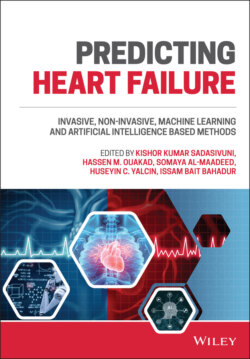Читать книгу Predicting Heart Failure - Группа авторов - Страница 23
1.4 Computer-Aided Diagnosis
ОглавлениеThe number of diseases and patients is increasing daily due to food-related problems, a sedentary lifestyle, and many similar reasons. Factors such as the complexity of the diseases, the increasing number of patients, and the aging of the world population have led to new searches in the field of health. Diseases are not old diseases, and their solution methods cannot be old methods. Being aware of this situation, health professionals and technology workers have joined hands and developed solutions for the health sector. In this context, many studies using technology in the field of health have been carried out [10]. Notably, using internet of things (IoT) sensor technologies, human movements have been monitored and abnormal situations detected [11].
The first solution that comes to mind regarding data collected with the help of IoT sensors is alarm generation resulting from abnormalities in the collected data, and sometimes making diagnoses and patient interventions the patient [12]. Abnormalities in patient movements or blood values are usually associated with a disease. For example, irregular tissue growths are related to cancer, and irregular heartbeats, heart diseases, and balance problems in the body are related to nerve diseases. IoT is a network where physical objects communicate with each other and with central systems. The use of IoT devices in disease diagnosis is carried out with the help of wearable technologies or additional components that make it possible to generate alarms about the patient with the help of systems that collect information, especially heart rate information, from the patient and transmit it to the center. This is carried out according to a method called anomaly detection in the name of alarm generation. An alarm is generated in case of an abnormality by comparing the last state of the patient with their recorded normal state. Thus, an approach similar to anomaly detection in networks provides the background for diagnosis based on IoT systems.
HF is a complex disease that occurs due to many different causes. The complexity of the disease makes its correct diagnosis a challenging problem for doctors. In addition, heart diseases, and especially heart attacks, are diseases that frequently affect people over the age of 65 who choose to live at home rather than a health center, and thus it is not possible to keep the patient’s condition under control. Due to the increase in cardiac diseases and the inability of patients to be under continuous control, studies to detect abnormalities in the heart before the onset of a crisis should be carried out earlier [13]. Early diagnosis is important as it affects the early intervention for the patient.
In the diagnosis of HF, the risk of HF is estimated based primarily on the patient’s clinical history, current symptoms, physical examination, and ECG. If all the measurements mentioned are normal, there is probably no risk, otherwise more detailed analysis should be done for diagnosis. Performing analyses allows specialists to identify patients who need echocardiography [14]. Diagnosis can be made with clinical methods, and decision support systems based on machine learning algorithms. From a machine learning perspective, HF diagnosis is a binary classification problem, a type of classification in which samples are assigned to one of two groups. For the diagnosis of HF, there would be two classes: “heart failure” and “no heart failure.” Thanks to machine learning, it can be understood whether the person being controlled has HF.
